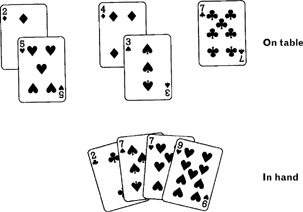The Penguin Book of Card Games: Everything You Need to Know to Play Over 250 Games (134 page)
Read The Penguin Book of Card Games: Everything You Need to Know to Play Over 250 Games Online
Authors: David Parlett



CommentConcentrate always on the objectives: to capture most
cards, most spades, Aces, the T, and the 2. Avoid trailing any of
the lat er, and work on builds rather than individual cards. Beware
of capturing a court if this leaves only numerals on the table, as
these may enable the next in turn to make a sweep. Do so only
when you have a good chance of making the sweep yourself.
Cassino. With this hand
you can sweep the board with a Seven. Bet er, though, is to play a
Seven to the Seven, announce ‘Building Sevens’, and sweep the
board on your next turn – provided your opponent does not hold a
Seven with which to sweep it first. You can’t increase the 2-5 or 4-
3, as they form a multiple build.
Diamond Cassino
(2-4p, 40c) A cross between Cassino and Scopa. Deal three each and
four to the table. Game is 11 up, counting 1 for cards (capturing 21
or more if two play), 1 for diamonds (capturing six or more of
them), 1 extra for 7, 2 for capturing al four Sevens or Sixes or
Aces, and 1 per sweep.
Draw Cassino



Any two-hand version of Cassino played in the fol owing way: after
playing a card, each completes his turn by drawing the top card of
stock to restore his original number of cards. There are no extra
deals. When the stock is exhausted the last cards are played out in
the usual way.
Royal Cassino
(2p, 52c) Basic Cassino but counting each Jack 11, Queen 12 and
King 13, so that court cards may be built or captured by combining
as wel as by pairing. As an optional extra, Ace may count 1 or 14
ad lib.
Spade Cassino
Cassino variant that replaces 1 for taking a majority of spades with
1 point for each spade captured, with an extra point each for J,
2 (Lit le Cassino) and A (by virtue of the score for Aces).
Royal Spade Cassino
A mixture of Royal Cassino and Spade Cassino.
Zwicker
2-4 players, 52 cards + 6 Jokers
A simpler and jol ier version of Cassino, Zwicker is described (by
Claus D. Grupp, in Schafkopf, Doppelkopf, Wiesbaden, 1976) as a
popular family game of Schleswig-Holstein.
PreliminariesFrom two to four players use a 52-card pack, to which
it is usual to add six Jokers of (preferably) the same back design



it is usual to add six Jokers of (preferably) the same back design
and colour as the main pack. Deal four cards each, and four face up
to the table. Stack the rest face down. When everyone has played
four cards, deal four more each so long as any remain in stock.
ObjectTo capture Aces, 7, 7, T, and to make sweeps.
PlayEach in turn, starting with eldest, plays a card face up to the
table, where it may capture either:
one table card by pairing; e.g. a Two captures a Two, a Jack a
Jack, etc.; or
two or more table cards by summing. For this purpose each
Ace counts 11, Jack 12, Queen 13, King 14; so a Queen might
capture 6-7, or 2-3-8, etc.
A played card may make as many captures as possible in one
turn. Capturing al the table cards is a sweep and is marked by
placing the capturing card face up instead of face down in the pile
of won cards. A sweep leaves the next player in turn no option but
to trail.
BuildingA player unable to capture must trail by adding a card to
the pool. He may, however, use it to form a ‘build’ by placing it
half over another card. In this case the build counts as if it were a
single card of their combined value, and may be captured but only
as a whole. For example, a Five played to a Seven makes a build of
12, which can later be captured by a Jack – or, if there is also a
Two on the table, by a King in conjunctionwith the Two, sincethe
Two and the 12-build are equal ed by the value of the King. More
discards may be added to a build, so long as it does not exceed 14
in total value.
Jokersmay be captured by matching. In addition, a Joker counts as
any desired value from 2 to 14, and may be played or captured
accordingly. Of course, it may only count as one value at a time: it

